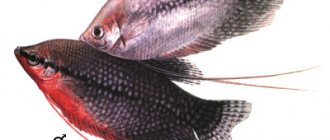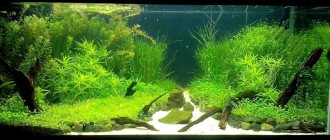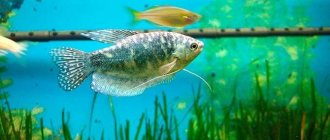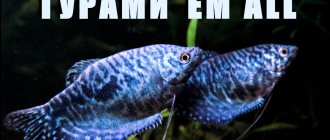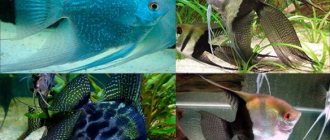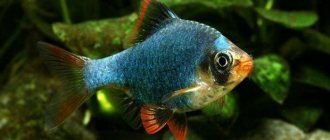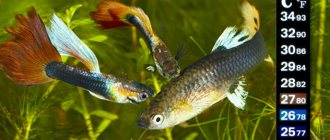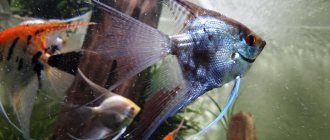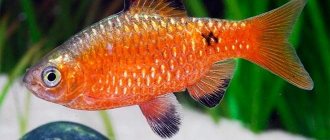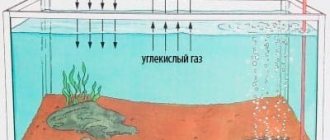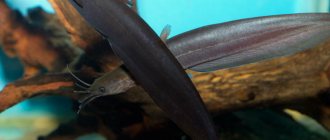Description
Gourami are able to breathe air from the surface using a labyrinthine breathing apparatus.
Appearance
Elongated, laterally compressed body. The pelvic fins are long, thread-like, and are used for sensing the surrounding space. The color varies from olive to silver. Pearlescent spots all over the body. The scales form a dark stripe in the middle.
In the wild they grow up to 12 cm. In captivity 7–10 cm.
Behavior
Labyrinth fish lead a peaceful lifestyle, do not fight for territory and do not attack other inhabitants of reservoirs. Pearlfish make sounds that are strong during the spawning period. They recognize the owner. Mother of pearl knocks down insects with thin streams of water.
Lifespan
Life span is from 7 to 9 years.
Natural habitats
This species was first described by Blecker in 1852. It is believed that these fish come from Thailand, Borneo and Sumatra.
Due to the fact that man greatly pollutes nature with his reckless actions, this species was included in the Red Book. Due to pollution, many fish of this species simply died, and catching such a fish in nature is a very rare occurrence. Pearl gourami, which are presented on the market for purchase, as a rule, were not caught in the wild - they are grown on special farms.
In the wild, the fish lives in swamps and rivers, as well as in lowlands. Water for wild representatives should be acidic and rich in various vegetation. There they feed on various insects and larvae.
Both pearl gouramis and their lalius (a related species) can hunt insects that do not live in water. If something flying near water is spotted, the individual releases a thin stream of water at it, thereby knocking it into the water.
Content
Pearl gourami adapts well to various conditions except cold. Lives a long time, eats any small food and acts as a nurse.
Aquarium
To keep 2-3 young pearl gourami, an aquarium of 40 liters is sufficient, for adults from 100 liters.
Water parameters
Gourami adapt well to new conditions. Maintain the following parameters in the aquarium:
| water temperature | 24–26 degrees |
| acidity | 6.0–7.0 pH |
| rigidity | up to 15 |
The air and water temperatures were at the same level.
Plants
Gourami hide and build nests in the bushes. Set up an aquarium, plant more plants so that there is room for movement. Lush algae such as elodea or pinnate will work well. Place floating plants, such as duckweed, on the surface. Make sure there is access to air.
Priming
A layer of 5–6 cm of coarse river sand, suitable for planted plants.
Place black stones and driftwood at the bottom; the gourami will stand out beautifully against the dark background.
Equipment
Fish love calm waters with minimal current. A new aquarium does not require filtration or aeration equipment.
Lighting
The pearl gourami fish prefers soft, warm light.
In which aquarium do fish breed?
If you are planning breeding in a common tank, it is advisable that it have a volume of at least 100 liters and a height of at least 50 cm. Since gouramis rise to the surface from time to time to breathe air, a pregnant female or future father may jump out and die. For this reason, the aquarium is covered with a lid.
We recommend reading
Black-striped and other cichlazomas
Gouramis like to have a lot of vegetation around, but at the same time, they need space for free swimming. They don't eat plants, so any algae will do, even those with a delicate texture. Grottoes and driftwood are also welcome. Together with algae, they will serve as shelter for pregnant females during the period of persistent courtship by the male.
Feeding
In nature, the main diet consists of small larvae, zooplankton and insects.
Pearl gourami aquarium fish eat live, frozen and artificial small food. Fish have small mouths, so don't feed them large foods. The basis of nutrition in the aquarium is industrial balanced food. To diversify the diet, during feeding, add bloodworms, chopped tubifex, coretra, and brine shrimp.
Gourami is distinguished by its ability to eat hydras and is considered an aquarium orderly.
They give food to the fish 2 times a day, but even with one-time feeding they will find food in the aquarium itself. They live up to 2 weeks without food.
Proper preparation of the father
The future dad is placed in a separate container and begins to be fed intensively. This is important, since it stops feeding while protecting its offspring and, without appropriate energy reserves, dies from exhaustion.
During this period, he needs live food. Bloodworms and tubifex are better suited than others. They are not only nutritious, but also contribute to the normal secretion of mucus for nest creation. You will have to feed all the fish in a common vessel. Enhanced feeding lasts 7-10 days.
We recommend reading
Which aquarium fish are the most unpretentious?
If the aquarium is large and you can easily divide the territory, it is more rational to plant 2-3 males. This is necessary for high-quality fertilization of eggs in case one male does not cope well with his duties.
The signal for gourami to start spawning is warming water, so maintain the temperature regime (28-29 degrees). It is easy to find out that the male is ready for fertilization: he begins building a nest. The dimensions of the foam structure are 6-7 cm.
As soon as the nest is ready (after 2-3 days), the pregnant female is released. Her rounded belly indicates her readiness to become a mother. It increases in size on all sides.
After the future parents have formed a couple, one can observe curious games of “lovers”.
Compatibility
The compatibility of gourami with other fish is difficult. Pearlies are very peaceful and timid. Aggressive breeds will not allow them to exist normally. Peaceful species can injure gourami by mistaking their fins for worms.
Neighbors not compatible with gourami:
- swordtails;
- goldfish;
- barbs;
- characins;
- cichlids.
Get along well with pearl ones:
- neons;
- iris;
- battles.
Conditions of detention
If the aquarist decides to keep gourami fish, the optimal care and maintenance for them should be selected. Since threadworms are medium-sized aquarium fish, the container for keeping them should be at least 40 liters, and the water temperature should be between 23-26 degrees, but its slight fluctuations will not harm the general condition of the gourami. The recommended acidity level should be 6-7 units, and hardness should not exceed 16.
Thread carriers are undemanding to a significant amount of oxygen in the water, so a little aeration will be enough. It should be remembered that once a week it is necessary to replace the water by at least 1/3. Since gourami like to swim in the middle and upper layers of water, it is recommended to cover the top of the aquarium with a lid to prevent the pets from jumping out of it.
Gourami can jump out of the aquarium, so it is worth covering it with a lid.
Feeding the Threadmen
Caring for and maintaining gourami is not difficult. However, novice aquarists who decide to acquire such fish may have difficulty deciding what to feed gourami in the aquarium.
Threadworms are not picky about their choice of food , so dry food is well suited for them. It should be borne in mind that in natural conditions they feed on insects, aquatic plants, as well as mosquito larvae. Therefore, periodically the fish should be introduced to the diet with live food (brine shrimp, daphnia or bloodworms).
Reproduction and breeding
Any novice aquarist can handle breeding gourami at home. To do this, you will need floating aquatic plants - duckweed, hornwort or ricci. You should also make sure that there is no strong current in the aquarium. It is desirable that during the spawning period the water in the container is stagnant, incapable of destroying the foam nest of fish on the surface of the water. The temperature should be in the range of 24−26 degrees.
During the mating season, the color of males becomes brighter, which attracts females. The process of creating a foam nest is interesting. It is built and maintained intact by the male. He does all this by releasing air bubbles from his mouth, which are connected with saliva. It takes several days to build such a nest.
During the breeding season, the male gourami makes a foam nest where the female lays eggs
After this, the male drives the female under the nest, which begins to release eggs. At this moment, the male fertilizes her. Since the eggs are light, they float to the surface, falling into air bubbles, where their further development occurs. The female lays about 200 eggs during one spawning, which lasts 3-4 hours.
The difference between gourami and other aquarium fish is that the father takes care of the offspring. During this period, you cannot feed the male. When the fry appear, you should take care of the water level, which should be no more than 10 cm. Therefore, ideally, it is recommended to breed threadworms in separate aquariums. This amount of water is necessary for small fish to properly form a labyrinth. As for feeding the fry, ciliates or yogurt will serve as food for them. You can also buy special food for gourami fry.
A male gourami cares for the newly born fry.
It will be necessary to monitor the development of the juveniles, as the larger fish begin to eat the smaller ones. Therefore, the only solution to preserve all offspring is to constantly sort the threadworms by size.
The main features of gourami breeding are:
- the selection of a male and a female should occur naturally: it is important that for one male there are 2-3 females, from which he will choose one;
- It is desirable that the age of the individuals be between 8-12 months;
For successful breeding, a male gourami must be at least 8 months old
- during the spawning period, the water in the aquarium should be clean and stagnant, minimal aeration is recommended;
- during the reproduction and development of fry there should be no irritating factors, so the sides of the aquarium can be covered with thick cloth or paper;
- Females can lay eggs without a nest - on the surface of dense thickets of aquatic plants.
Before you start a gourami in your aquarium, you should take care of the living conditions. Any type of threadworm will require a significant amount of dense plants, snags, as well as places for shelter, since the fish have a somewhat timid character. However, you should not forget about the space for the gourami to move freely, so you will need an aquarium of at least medium size.
Reproduction
It is possible to breed gourami at home both in a general and in a separate aquarium. But if there are neighbors, the fry may suffer.
Breeding pearl gouramis does not require special skills and is accessible to beginners in aquarium keeping, however, there are some features:
- a pair is chosen for spawning - a male and a female who do not show mutual sympathy will not produce offspring;
- optimal breeding of pearl gouramis at the age of 8–12 months;
- when the female is ready to lay eggs, her abdomen is greatly rounded;
- during dilution, keep the water crystal clear;
- When spawning, provide the gourami with privacy by covering the aquarium with sheets of paper.
Differences between a male and a female
Male gourami are larger in size and have brighter colors, females are more rounded. The dorsal fin is pointed in males and rounded in females. The throat is red in males and orange in females.
Differences during spawning: Boys have a bright red belly.
Spawning
Preparation for spawning has a number of features:
- 6–8 days before mating, plant the gourami;
- feed only live food, but not cyclops or daphnia, otherwise the parents will eat their own fry;
- Spawning can also occur in a community aquarium, but the risk of death of the fry increases.
For a prepared pair, set up a spawning area:
- volume from 30 liters;
- sandy soil;
- It is necessary to have a riccia plant - natural material for the nest;
- Maintain the water level to 15–20 cm;
- the aerator is not used in the spawning tank due to the risk of destruction of the nest;
- for successful spawning, softer water is required - 4–8;
- temperature 29 degrees.
Place the male in the spawning tank first. After a day, replant the female.
The color before spawning becomes more intense and the gouramis show themselves in all their beauty. The male builds a foam nest, for which he swallows air and, moistening it with saliva, forms small bubbles, attaching them to the riccia. Without this plant, the structure will not be strong. A foam cap with a diameter of 5–7 cm and a height of 1–4 cm is built within 24 hours, during which time the female is not allowed to the nest.
The spawning of pearl gourami itself lasts from 2 to 4 hours. At this time, the male pushes the female to the finished nest, and when he approaches, he wraps himself around her, squeezing out and fertilizing the eggs. Spawning occurs in several passes. Afterwards, the male collects the eggs that did not make it into the nest with his mouth, transfers them to the intended place and sticks them to the foam with the help of saliva.
Upon completion of the process, the female is immediately removed, and the male remains to take care of the offspring. From 200 to 2000 eggs are spawned at a time.
The larvae form from 24 hours to 3 days, depending on the water temperature. All this time, the male takes care of the eggs and the already hatched fry. On the 4th day, the adult leaves, and the young begin an independent life.
Caring for fry
Growing new fish is subject to the following rules:
- After transplanting the males, lower the water level in the spawning tank to 10 cm and maintain it for 3 weeks. This time is enough for the fry to develop a labyrinthine breathing apparatus.
- The first week the diet consists of ciliates and plankton. Then the feed is enlarged.
- For the first month of life, give the fry only live food.
- A month and a half after hatching, reduce the water temperature to 25 degrees.
- Artificial aeration is carried out with low intensity.
- In the first month and a half of life, gourami are especially vulnerable. Death can be caused by low temperature or lack of food.
- Add water daily by 10% of the volume.
- Clean the aquarium from food debris in a timely manner.
- The fry eat the weakest; in order to preserve the offspring, separate the gouramis by size.
Reproduction of aquarium fish pearl gourami
If male gouramis begin to build a foam nest, they are ready to breed. Usually this happens at the age of one year. The male can and should be helped. Firstly, the water level in the aquarium during this period should not exceed 15 cm. Secondly, it needs building materials - therefore it is advisable to put small floating plants in the spawning tank. They will also help the female to hide from the annoying advances of the male after spawning.
Gourami can also breed in a community aquarium. But if this does not happen, then reproduction must begin by “moving” the male from the main aquarium to the spawning area. In a spawning tank with a volume of 15-20 liters there must be standing water so that the built nest does not collapse, the water temperature is heated to 28-29°C.
The male spends all his time around the nest, the diameter of which reaches 7 cm. This is the future place for offspring. When the male has already acquired such a place, the female is transplanted to him.
A pregnant gourami looks like other pregnant fish - it has a rounded abdomen. And the male sees this. If the female is ready for spawning, then he immediately begins to court her in every possible way, changes color and becomes especially beautiful. If the female is not ready, she can drive her until she loses her tail and fins, or even to death. Before spawning, spawners are heavily fed.
Diseases
Gourami have strong immunity, but are susceptible to some diseases. If there are unusual changes in appearance or behavior, transfer the fish to another container. Before planting in the main aquarium, be sure to quarantine newcomers for at least 2 weeks.
The most common causes of diseases:
- injuries during transplantation or transportation;
- improper care;
- mismatch of water parameters;
- a sharp drop in temperature;
- excess food;
- poor-quality food or food contaminated with parasites.
More often, health problems are caused by the difference between water and room temperatures. By swallowing cold air, gouramis catch colds. Treatment consists of adjusting temperatures.
Diseases caused by fungi, parasites and viruses are diagnosed by veterinarians. Treatment will be bathing in a weak salt solution or with the addition of potassium permanganate.
With easily curable diseases come more dangerous ones:
- Lymphocystosis.
- Pseudomonosis.
- Aeromonosis.
Lymphocystosis
Dangerous viral disease. Main features:
- wounds surrounded by blisters all over the fish’s body;
- quickly appearing growths of gray or cream color.
The disease begins to develop from the fins, gradually covering the entire body. The danger of the disease lies in the rapid development and release of the virus into the water, which infects all the inhabitants of the aquarium.
Treatment:
- if only the fins are infected, cut off or cauterize them;
- an individual with affected skin cannot be treated;
- carry out complete disinfection of the aquarium;
- replace plants with new ones;
- quarantine all fish.
Pseudomonosis
Infectious acute disease. Infection occurs through the entry of pseudomanad microorganisms into the aquarium with soil or vegetation. Dark spots appear on the body, quickly transforming into ulcers.
Carry out the treatment in a quarantine aquarium without plants:
- keep the fish for 10–20 minutes in a solution of potassium permanganate 0.5 g per 10 liters of water;
- once a day, add bicillin-5 at 500,000 units per 100 liters of water.
Aeromonosis
A contagious disease that is difficult to treat. The source of the disease is live food combined with low temperature and pollution.
Main features:
- refusal to eat;
- inactivity;
- the fish lie on the bottom;
- bloating;
- bloody spots on the fins and body;
- tousled scales.
Treatment is the same as for pseudomonosis. Effective until the appearance of shaggy scales.
Completion of mating and appearance of offspring
At the end of spawning, the male becomes aggressive. He drives the female away from the nest and with all his appearance demonstrates his reluctance to tolerate her presence. At such moments, many females lose their tails and fins, because the father gives a real beating to his overly annoying girlfriend. The weakest of them even die.
Only the father takes care of the common offspring, protecting the precious eggs. Mom does not show any interest in the laying, although there are times when she tries to intervene in the process, but is quickly rebuffed . For all the above reasons, after spawning, the female is placed back in a large aquarium; she will be ready to breed again in 3-4 weeks.
The incubation period is 35-36 hours, and then the fry emerge. They look like little hooks with big eyes. After 4-5 days, the larvae become like real fish.
We recommend reading
How to feed fish in an aquarium
When the larvae appear, the father is also removed. His instincts are noticeably weakened and lose their meaning. Sometimes, if the temperature regime is disturbed, the male may show a tendency towards cannibalism. Removing him from the “maternity hospital” prevents such a situation.
Reviews
Gourami owners speak about pearls in completely different . Some admire the colors of the aquarium resident, others claim that the peaceful nature is a myth.
Adviсe
- transportation is an important step, do not damage the fins when moving or transplanting;
- cleanliness and temperature of the water are the key to the health of pearl fish;
- a spawning pair that does not show mutual sympathy will not produce offspring;
- mandatory quarantine for newcomers;
- Do not house gouramis with aggressive species.
Exotic and fascinating pearls will decorate the aquarium and will not harm the neighbors. Pearlescent gourami is an excellent option for beginner aquarists.
Previous
FishMiniature shark in an aquarium is a shark ball
Next
FishAttractive Blue Dempsey Cichlid
Care of offspring
Only the papa gourami looks after the nest with eggs, and he is very jealous of his duties. He carefully returns the eggs that have fallen out of the foam. About one and a half to two days pass and the larvae emerge from the eggs. And after another three days they will turn into full-fledged fry. If the larvae cannot swim on their own, then daddy makes sure that the babies do not sink to the bottom. Then the fry is already able to move independently. He no longer needs daddy's care and the male can also be removed. And by this time, the paternal gourami also begins to lose its parental instinct. He begins to get nervous because he is no longer able to keep track of the offspring that are spreading out in all directions, begins to show aggression and may even eat all of his offspring, which he so carefully looked after just recently .
After a couple of days, small gourami larvae can be seen in the nest.
While the eggs are ripening and the larvae are growing, you need to carefully monitor the water temperature in the spawning aquarium. After all, as soon as the fish feels that the temperature has begun to drop, he will immediately stop caring for the offspring, destroy the nest and eat the eggs and the babies that appear.
After the male has been removed, the foam nest begins to gradually fall apart on its own, and it is no longer needed. Babies should be fed first with ciliates, later switching to zooplankton. Since the fry grow at different speeds, those who grow faster must be removed, because they can mistake small things for food.
Only three weeks after hatching from the eggs, the babies will develop a labyrinthine apparatus, so the water in the “catch” should be clean and enriched with oxygen, with a constant temperature in the range of +27-29°C. You can begin to gradually reduce it after a month and a half.
Moving a nest from a community aquarium
If the fish spawned in a community aquarium, the nest must be moved, otherwise all the offspring will be eaten.
But what to do and how to breed if the process of building a nest has already begun in a general aquarium, where conditions for gourami spawning are not entirely suitable. In this case, let the pair spawn, and then carefully pick up the foam nest with eggs using a saucer and transfer it to an aquarium where the temperature is the same as in the general aquarium. Move the male there too so that he can continue caring for the offspring. And then the whole process is the same as if the fish laid eggs in a pre-prepared spawning area.
Reproduction of these beautiful labyrinth fish is not that difficult, and the joy from the process of watching the emergence of new lives is incomparable.
